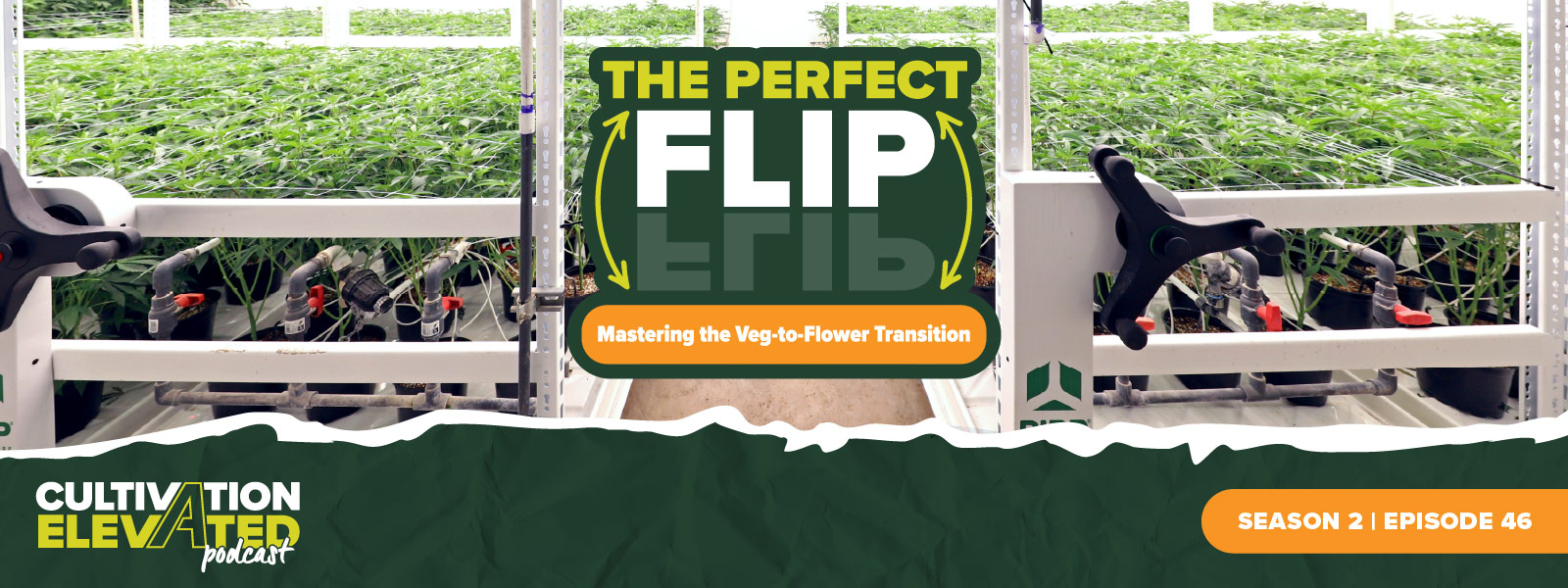Season 2 | Episode 46: The Perfect Flip: Mastering the Veg-to-Flower Transition

Summary:
Podcast Episode Summary:
In this episode, Michael and Anders talk about the most crucial phase of a cannabis plant’s lifecycle, the transition from vegetative growth to flowering, often referred to as the “flip.” This 10-day window determines the yield ceiling for the entire cycle, and missteps made here can’t be recovered later.
They unpack the physiological, environmental, and operational shifts that must be managed with precision - including lighting, VPD (vapor pressure deficit), CO₂, and irrigation. The hosts emphasize DLI matching, gradual environmental ramping, and avoiding compounded stress from practices like pruning, high EC, or VPD swings.
From there, they discuss crop steering, humidification gaps in modern facilities, and how these can lead to common visual cues like red stems. They finish by breaking down canopy management and topping strategies, stressing the importance of genetic familiarity (“crop registration”) and lean facility management, optimizing plant density, minimizing unnecessary touches, and streamlining trellising and labor practices.
Episode Breakdown
Intro
0:00–1:11
Episode intro and context
“Today’s topic: the critical veg-to-flower transition, why it defines your yield ceiling.”
Lighting, VPD, and CO₂ Management
1:11–8:19
Importance of not “stacking stress” during transitions
DLI matching: adjust intensity to maintain consistent light exposure, moving from 18-hour to 12-hour photo periods
VPD matching: avoid sudden drops in humidity that shock plants
Common error: flower rooms without humidifiers → causes high VPD (1.5–2.0) and plant stress
CO₂ strategies: start near veg levels (~800 ppm) and ramp up gradually (to ~1200–1400 ppm)
Key insight: Match environment and plant readiness; avoid drastic changes.
Compounding Stress & Crop Steering
8:19–10:59
“Don’t add stress on top of stress”, physical movement, pruning, environmental changes all add up
Early flower is already generatively steered (intentional stress); don’t layer more
Humidification systems are often overlooked, essential to prevent high early-flower VPD
Lack of humidity + high EC = red stems, delayed growth
Key insight: High VPD early in flower + high EC = recipe for osmotic stress and nutrient toxicity.
Balancing EC and Climate
10:59–14:37
If humidity is low, lower your EC to avoid overfeeding and lockout
Root zone and environment are intrinsically tied, don’t treat them separately
Gradual EC ramping over first 10 days is safer
If your environment can handle it (good humidity control), you can run higher EC from day one
Key insight: Always balance VPD and EC, the law of minimums applies.
Canopy Management
14:37–19:09
Transitioning to talk about stretch, topping, pruning, and defoliation
General rule: avoid heavy manipulation during early flower, let plants focus on hormonal transition
“Top or not top?” → depends on plant density and local regulations
Untopped, high-density canopies preferred when allowed
Introduces the concept of crop registration, grouping cultivars by growth behavior (short/medium/tall, heavy/light feeders, etc.)
Key insight: Know your cultivars before applying a one-size-fits-all canopy strategy.
Pruning & Hormonal Shifts
19:09–22:00
Timing matters, do skirting and light pruning in late veg (5–7 days before flip)
Avoid topping right before transition; it causes hormonal confusion
Plants experience dual hormonal stress if topped right before 12-hour flip
Use lean principles: minimize unnecessary handling and repetitive labor
Key insight: Don’t make hormonal transitions harder, time pruning and topping well before the flip.
Lean Practices & Trellising
22:00–23:01
Discussion on over-trellising, three layers often unnecessary
Suggests laying two trellises at once for efficiency and reduced labor
Highlights lean movement and eliminating wasted effort
Key insight: Efficiency in canopy management = more consistent, less-stressed plants.
Treillage & Canopy Prep
23:20–25:20
Self-analyze workflow, are you making things unnecessarily complicated?
Trellis early and spread plants evenly; avoid overspreading.
Ideal: one top per trellis square; fill canopy without damaging plants.
Timing is critical. Too late and branches snap or stress the plant.
Key insight: Proper trellising prevents structural stress and maximizes canopy density.
Substrate & Rooting Strategy
25:49–29:45
Two main approaches: root in place during veg or transplant at flip.
Transplanting introduces a small delay in vertical growth, with roots before shoots.
Veg-in-place adds 3–5 days of flower-time delay; financial implications vary by state.
High-value markets can justify veg-in-place for optimal root development.
Key insight: Root readiness drives plant readiness more than shoot size.
Plant Readiness for Flip
31:01–34:00
Look for mature root and shoot structure capable of supporting aggressive flowering (56–63 days).
Healthy apical growth ensures balanced nutrient uptake and vigor.
Smaller substrates (1–3 gal) root faster, allowing quicker flips.
Key insight: Don’t flip a plant too early, root mass is the limiting factor for flower success.
Operational Pitfalls
34:29–36:00
Flipping too early: lower yield density, inconsistent canopy.
Flipping too late: light competition, airflow restrictions, pest/mildew pressure.
Team misalignment: irrigation techs, plant techs, HVAC operators need a shared checklist.
Key insight: Operational coordination is as critical as plant biology.
Digital Prep & Metrics
35:50–37:25
METRC & control system must align with Day 1 of flower.
Check climate recipes, fertigation, day tank levels, and cleaned lines.
Activate production trackers to monitor plant growth by day and week.
Key insight: Digital alignment prevents overlooked errors and ensures smooth transitions.
Takeaways
Match DLI and VPD from veg to flower to minimize stress
Use gradual environmental and EC ramping
Avoid stacking multiple stressors (move, prune, defoliate, flip all at once)
Implement humidification systems early in flower
Know your genetics — tailor canopy and irrigation to cultivar behavior
Apply lean practices — fewer touches, smarter trellising, efficient workflows
About Cultivation Elevated
If you are a grower looking to optimize your cultivation facility or anyone looking to cultivate more in less space, then this is the show for you. Each week, join Host Michael Williamson as he travels across the country, to explore the world of vertical farming and the future of cannabis and food production through his conversations with leading industry operators, growers and executives who are demonstrating success and resilience as growers and cultivators. Each episode provides stories and key insights that will inspire and show you first-hand, how each of these companies have overcome challenges, and found their own path to success.
